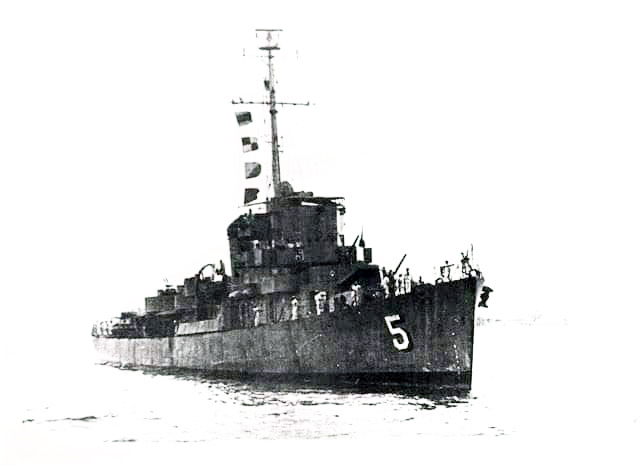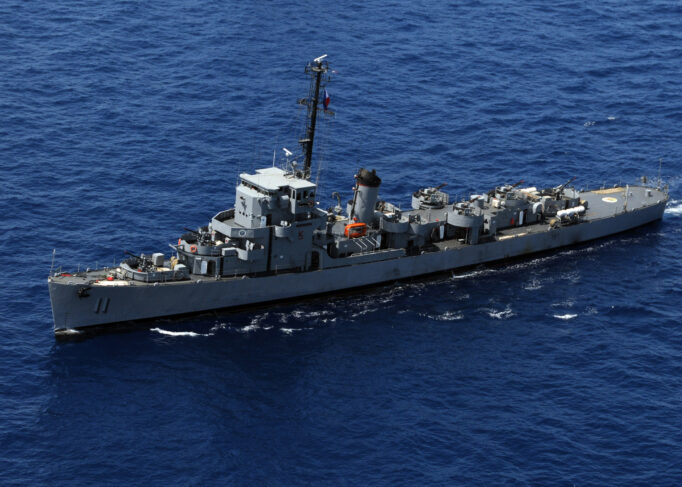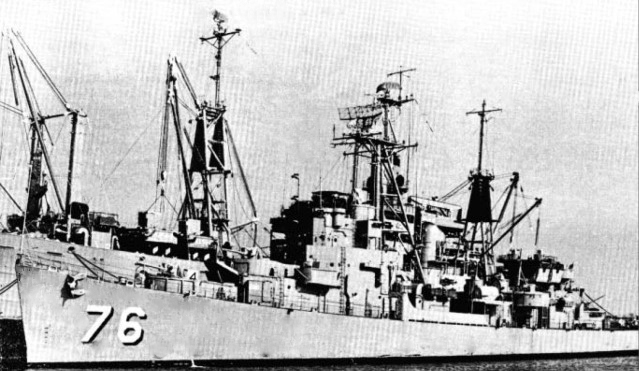The Philippine Navy is one of five Asian navies that possessed the Cannon Class Destroyer Escort apart from the Japanese Maritime Self Defense Force (JMSDF), Republic of China Navy (ROCN), Republic of Korea Navy (ROKN), and the Royal Thai Navy (RTN).
The Philippine Navy inducted into service its first Cannon Class Destroyer Escort (known in Filipino Naval Service as the Datu Kalantiaw Class Frigates on 15-December-1967 when the former USS Booth (DE-170) was loaned to the PN under the United States Military Assistance Program. After 21 years in service, she was bought under the Foreign Military Sales Program in 1978.
The lead ship of the class, she would be joined by RPS Datu Sikatuna (PS-77/PF-5) and RPS Rajah Humabon (PS-78/PF-6) on 27-February-1980 on a joint commissioning of the 2 warships.
Prior to their entry into PN, RPS Datu Sikatuna was the former USS Amick (DE-168) who served the USN from 1943 to 1947. She was then transferred to the Japanese Maritime Self Defense Force on 14-June-1955 along with another Cannon Class DE the USS Atherthon (DE-169) serving as the first capital warships of the postwar Japanese Navy. They were named JDS Asahi and JDS Hatsuhi (DE-263) in JMSDF service.
USS Atherton has a U-Boat credit to her sinking the U-853 during one of World War Two’s last naval battles off the American East Coast. As more warships joined the JMSDF, they were returned to the United States Navy after 20 years of service.
Both were transferred to the Philippines on 13-September-1976 under the Excess Defense Articles (EDA) program of the United States. After undergoing refurbishment in South Korea, they were commissioned in Philippine Naval Service on 27-February-1980.
While still in refit in South Korea, Two Cannon Class Destroyer Escorts were also returned by the Republic of Korea Navy to the US Navy in 1977, who also transferred the two ships to the Philippine Navy. Regrettably, the ROKN ships (ROKS Kyong-Ki and ROKS Kangwon) were never commissioned but were utilized as spare parts source for Rajah Humabon and Datu Sikatuna.
By March 1980, the 3 ships now form the backbone of the Philippine Fleet along with the 4 former South Vietnamese Navy (SVN) Weather High Endurance Cutters (Andres Bonifacio Class) and the sole ex-SVN Destroyer Escort Radar Pickett BRP Rajah Lakandula (PF-4).
The Loss of BRP Datu Kalantiaw (PS-76)
On 21-September-1981 tragedy struck the Philippine Navy with the loss of its Flagship and one of its Cannon Class Destroyer Escort off Calayan Island, Province of Cagayan, 340 miles north of Manila during the height of Typhoon Clara.
The tragic event was considered as the worst naval disaster that be-fell the Navy as 79 out of the 97 of the Destroyer Escort’s crew perished.
The USS Booth was a Cannon Class Destroyer Escort (DE-170) of the United States Navy from 1943 to 1967.
Her keel was laid on 30-January-1943 at Port Newark New Jersey and she was launched on 21-June-1943 and commissioned into US Naval Service on 19-September-1943. After the Second World War she was decommissioned on 10-December-1945 from the U.S. Navy and relegated to reserve status.
Her namesake in Filipino service is the Chieftain of the Province of Negros (circa 1433) who wrote the Code of Kalantiaw (who many historians now consider a hoax and also the National Historical Institute (present day NHCP) in 2004.
She was sold to the Philippines in 1978 under the Foreign Military Sales (FMS) program.
In the 1980 re-classification of naval ships, the pre-fix RPS (Republic of the Philippines Ship) was changed to BRP (Barko Ng Republika ng Pilipinas) in which PS-76 followed suit.
RPS Datu Kalantiaw became the first of the three Cannon Class Destroyer Escorts operated by the Philippine Navy and part of the Naval Operating Forces (NOF).She was the designated flagship of the Philippine Navy until she met her untimely demise. She was also the flagship of the Task Force to the Spratly’s Island in the South China Sea when we made our first military ventures in late 1969-70. Her notable actions made were Naval Gunfire Support (NGFS) in the Southern Philippines during the height of the Counter Insurgency period.
Typhoon Clara
Locally named Typhoon Rubing begun as a tropical depression on 13-September-1981 east of the Philippines, moving from westward to northwest it transformed into a tropical storm and into a typhoon a day after. Her strength with peaked winds measuring 220 kph with northern Luzon as it area and weakened on the 21st as she approached Hong Kong and the Chinese mainland. On land, the massive destruction caused by the typhoon took a toll of 141 dead.
The 1,220-Ton Destroyer Escort Kalantiaw skippered by Commander Carlito Donato PN with 10 Officers and 87 Enlisted Personnel was part of the Northern Task Force under Captain Arturo Blancas PN when it was unmoored of the port of Camiguin Island where it tried to seek shelter from the typhoon midway. The Task Force Commander was also aboard on that fateful day.
But the warship was washed and battered by heavy waves until it was pushed to the rocky cliffs of Calayan Point, Cagayan Valley. As per survivor’s account by Petty Officer Jaime T Caldito PN the ship drifted for 18 hours battling 100 foot heavy waves bigger than the ship, as recounted the officer’s and crew fought valiantly against the forces of nature. The ship flipped to its side and capsized.
The surviving officers and men of PS-76 lashed themselves on secured areas of the ship to avoid being awashed until the storm dissipated, though most of the crew were swept overboard while others were found on the ships compartments victims of deadly gas fumes. Only 3 Officers out of the 10 and 15 of the 87 Enlisted Personnel survived the ordeal.
The names of those lost are now immortalized in the Sailor’s memorial at Naval Base Heracleo Alano (Sangley Point) Cavite.
On the following day 22-September-1981, a massive Search and Rescue (SAR) operation was initiated and most of the Philippine Navy units and US Naval units from Subic Bay deployed to the area in which as USS Mount Hood (AE-29), USN and USAF Helicopters approached the incident site they found 13 floating bodies, while the rescued crew were brought to Laoag City, Province of Ilocos.
During the rescue, rescuers from both Navies and Air Forces also fought nature’s fury as they still encountered heavy waves on reaching the site and the ship. Other than that, below water operations were not conducted due to corals, riptides and the presence of sharks.
Listed below are the units of the Philippine, US Navy and USAF involved in the rescue.
Philippine Navy:
- Destroyer Escort Radar Picket BRP Rajah Lakandula (PF-4) under Capt Robert Holgado Bruce, the First PN vessel to reached the tragedy site.
- Corvette BRP Rizal (PS69)
- LST BRP Tarlac (LT-500)
- LST BRP Aurora (LT-508)
- Transport Ship BRP Mactan (TK90)
- Naval Aviation Group PN
- MBB/PADC BO-105 Helicopters
- Britten Norman BN-2 Islanders
United States Navy:
- USS Mount Hood (AE-29) (Ammunition Ship Commanded by CMDR M.E Burke with Executive Officer LCDR Richard Charuhas USN)
- USN Explosive Ordnance Disposal Unit One- Detachment 21
- LTJG DeSimone (Officer-in-Charge)
- BM1 (DV) Murphy
- GMG2 (DV) Lounsbury
- BT2 (DV) Maves
- Additional Divers
- LCDR Boyd (CTF 73 Salvage Officer)
- LCDR Steding (SRF Diving Officer)
- HT1 (DV) Hettenhouser (SRF)
- BM2 (DV) Brigham (SRF)
- BM2 (DV) Smoot (SPECWARGRU ONE)
- BM3 (DV) Troutman (SPECWARGRU ONE)
- HM3 (DV) Hancock (SPECWARGRU ONE)
- Philippine Navy Liaison to USN EOD 1-DET 21-LTJG Austria, PN
- Fleet Composite Squadron 5 (SH-3 Seaking Helicopters)
- 1USN Lockheed P-3 Orion
United States Air Force:
- Helicopters (HH-3 Jolly Green) of the Military Airlift Command’s Aerospace Rescue and Recovery Service (ARRS), Clark Air Force Base, Pampanga, Republic of the Philippines
- 1 USAF Lockheed C-130.
THE FINAL YEARS

BRP Datu Sikatuna (PF-5) formerly USS Amick (DE-168)
The loss of PS-76 left BRP Rajah Humabon and BRP Datu Sikatuna to soldier on. After 9 years of service, BRP Datu Sikatuna was decommissioned and some of her parts were cannibalized for her sister. By the middle of 1980s, her hull number was changed from PS-78 to that of PF-5 and classified from Patrol Ship to Patrol Frigate similar to the US designation of its Frigates during the Second World War.

BRP Rajah Humabon (PF-11) at Balikatan 2010. Photo Credit: U.S. Navy photo by Mass Communication Specialist 2nd Class Mark R. Alvarez. Source: Philippine Navy files.
BRP Rajah Humabon was then showing of age and in 1993, she was decommissioned as there were high hopes of the 1995 AFP Modernization Program were seen and new assets to be acquired. A volatile security situation arose in the South China Sea in 1995 with the Chinese occupation of Mischief Reef. By 1996, BRP Rajah Humabon now re-numbered to PF-11 was re-commissioned along with some Patrol and Auxiliary vessels. PF-11 was re-engined during the earlier refit. She was also designated as the Flagship of the Fleet taking over from the now decommissioned BRP Rajah Lakandula, most of her tasks were maritime patrols in the South China Sea and Naval Gunfire Support in the Southern Philippines.
She was present during the tensions in the Spratlys area in 2008 to 2011. By 2016, she was again re-numbered to PS-11 and utilized as a ceremonial ship welcoming foreign warships at Manila Bay, due to her age and hull problems she was decommissioned on 15-March-2018 with 4 years in the United States Navy, 20 years with the Japanese Maritime Self Defense Force and 35 years with the Philippine Navy for a total of 79 commissioned years in Three Navies.
There were plans for BRP Rajah Humabon to become the first museum ship of the Navy along with decommissioned Patrol Craft Escorts and Patrol Killer Mediums at the Sailors Memorial and Fleet Museum, Naval Base Heracleo Alano, Sangley Point, Cavite.
Sources:
Books:
- The Philippine Navy in the New Society,1976, Headquarters Philippine Navy.
- Jane’s Fighting Ships 1953-1954 for JMSDF Data on the Cannon Class Destroyers JDS Asahi and JDS Hatsuhi.
- Jane’s Fighting Ships 1974-1975
- Jane’s Fighting Ships 1977-1978
- Jane’s Fighting Ships 1984-1985
- Jane’s Fighting Ships 1994-1995
- Combat Fleets of the World 1986-1987
- Combat Fleets of the World 1976-1977 for data on the ROKN Cannon Class.
- Conway’s All The World’s Fighting Ships 1947-1995.
- The Philippine Navy 1898-1998 by Commodore Regino “Dodds” Giagonia AFP (Reserve), 2000, Headquarters Philippine Navy.
